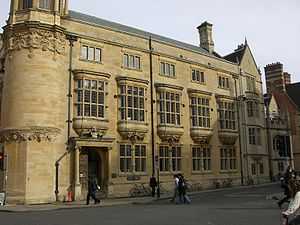Indian Institute

The Indian Institute in central Oxford, England is located at the north end of Catte Street on the corner with Holywell Street and facing down Broad Street from the east.[1] Sir Monier Monier-Williams started the Institute in the University of Oxford in 1883 to provide training for the Indian Civil Service of the British Raj.[2]
History and building

In June 1881, plans were submitted to the University of Oxford's Hebdomadal Council to build an Indian Institute. The original site was occupied by four old buildings. The building was designed by Basil Champneys and the first section opened in 1884. Originally there was a low shop to the south, but neighbouring Hertford College has now encroached on the Institute with a much taller building. The Institute was built of Milton stone in the style of the English Renaissance, with different oriental details to the designs of Champneys. In 1974 Nikolaus Pevsner observed that the rounded corner cupola made an excellent point de vue at the east end of Broad Street.
Along with the library (see below), the institute contained lecture rooms and a museum. Some contents of the museum are now present in the Ashmolean and Pitt Rivers Museums. The original Indian Institute building is now the Oxford Martin School of the University of Oxford, the History Faculty having moved to the old City of Oxford School building on George Street and its library to the Bodleian site.
Indian Institute Library
The Indian Institute Library opened in 1886. It became a dependent library of the Bodleian Library, the main library of the University, in 1927. It specialises in the history and culture of South Asia, especially the Himalayas and Tibet.[3] The library was formerly located in the Indian Institute building, but was moved to the top floor of the New Bodleian Library.
Accusations of racism
The building was financed entirely by private donors in India and Britain, for the sole purpose of constructing an edifice to house study for and on the Indian sub-continent. There was consequently great controversy in 1968, when the University's governing council evicted the Indian Institute from the premises without compensation, and then made a gift of the premises to the History Faculty, which specialises in European history to the exclusion of Indian history. The government of India filed a formal protest on behalf of the families of the original donors, who felt defrauded by the University's actions. The Oxford University Student Union went further still, accusing the University administration of racism in the decision.
The Institute's aim
The aim of the Indian Institute was:
- The work of fostering and facilitating Indian studies in the University; the work of making Englishmen, and even Indians themselves, appreciate better than they have done before the languages, literature and industries of India.[4]
See also
- University of Oxford
- Departments of the University of Oxford
- Buildings and structures in Oxford
- Oxford Centre for Hindu Studies
- Hertford College
- Oxford Martin School (currently housed in the old Indian Institute building)
References
- ↑ "1911 Encyclopedia reference on Indian Institute". Retrieved 2007-03-02.
- ↑ "From the extract of Kelly's directory for 1900.". Archived from the original on 2007-02-09. Retrieved 2012-08-03.
- ↑ Bodleian Library: Department of Oriental Collections: 'Indian Institute Library', http://www.bodley.ox.ac.uk/dept/oriental/iil.htm, accessed 2007-02-14.
- ↑ "Aim of the Indian Institute". Archived from the original on 2006-10-01. Retrieved 2007-03-02.
External links
| Wikimedia Commons has media related to Indian Institute, Oxford. |
- Old Indian Institute, Broad Street, Oxford (including photographs)
- Indian Studies at Oxford from the Oxford Centre for Hindu Studies
- Indian Institute Library now in the Bodleian Library
- The Oxford Centre for Hindu Studies
Coordinates: 51°45′17.5″N 1°15′15.0″W / 51.754861°N 1.254167°W